It was announced on Sunday that painter, poet and novelist Etel Adnan has died at the age of 96. In 2018, Gabriel Coxhead visited the Lebanese American artist in her home in Paris as she was preparing for an exhibition at the Zentrum Paul Klee in Bern and the interview appeared in the June 2018 issue of Apollo.
There’s something curiously familiar about visiting Etel Adnan’s apartment in Paris. Not that I’ve ever been there before. But in recent years it has become a sort of cult destination for art-world figures, mentioned and mythologised by the various curators and critics who go to meet her, as well as depicted in film-portraits of the artist. Her desk and workspace were even recreated for an exhibition in 2015. And there are all the inevitable associations that come with being an artist of a certain age and living in Paris. Adnan is 93, and her apartment is in the 6th arrondissement, with its history of intellectualism and bohemianism. The way she lives seems to reflect that milieu. Bookcases are heaving, oriental rugs cover the floorboards, the walls are filled with paintings – her own colourful abstractions, as well as works by friends. Ceramic sculptures by Simone Fattal, Adnan’s partner of over 40 years, dot most surfaces. A large mirror designed by Man Ray hangs in the hallway.
Yet it does Adnan a disservice to characterise her as some modernist doyenne, a relic from another age. Her history is far more complex and multifaceted. Born in 1925 in Beirut, she first moved to Paris in her twenties, on a scholarship to the Sorbonne – but to study philosophy, not art. Within a few years she had relocated to the United States, and by the late 1950s was teaching philosophy of art and aesthetics in a small college in San Rafael, California. And although she also began painting, after being challenged by a friend to put her theoretical ideas into practice, it was another art form, poetry, with which she initially made her name. In the States, indeed, she still tends to be regarded primarily as a poet, one of the foremost voices to emerge from the Bay Area’s radical, anti-war movement in the ’60s. It was only when a suite of her paintings was included in the 2012 edition of documenta that, at the age of 87, she suddenly began to attract widespread recognition for her art.
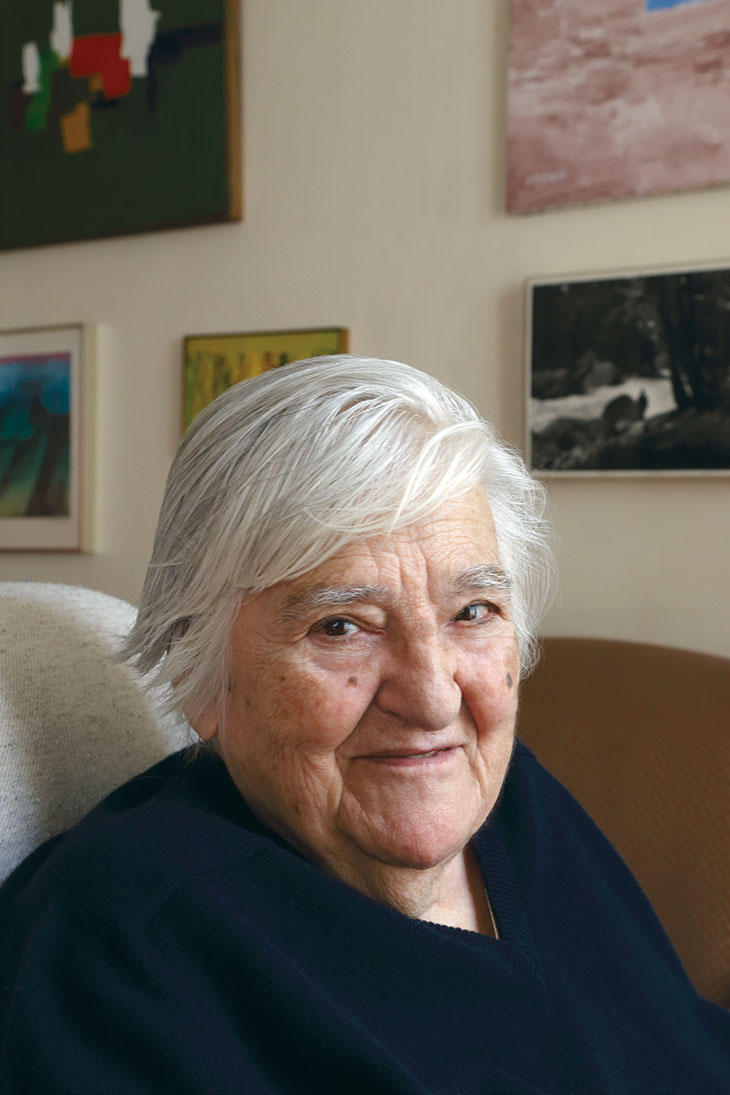
Etel Adnan, photographed at home in Paris, April 2018. Photo: Elizabeth Young
Ensconced in an armchair, her back to the windows letting in afternoon sunlight, Adnan smiles as we discuss the vagaries of her career. ‘I have been painting since 1959, 1960,’ she says, in a heavy Middle Eastern accent. ‘I had little shows here and there, and I was known by few people. But I had a nice time, working in my corner, as you would say. Then I showed with documenta, and became known overnight. It was funny, because all the newspaper reports started with my age. It was funny in the beginning, but in the end it was annoying, as if my age were the story.’
Still, it is quite a story. In the six years since documenta, Adnan has gone on to have shows in some of the world’s biggest commercial galleries, such as White Cube, not to mention important public spaces like the Serpentine or biennials such as the Whitney. Her late-career success is emblematic of a broader trend in the art world, with a whole host of other overlooked or marginalised artists, especially women, being rediscovered and promoted. Adnan’s attitude remains phlegmatic. ‘It’s nice to be making more money from my art than before,’ she acknowledges, ‘even if I’m too old to really have much to spend it on.’
What she does seem to be enjoying is the opportunity for interesting conversations. She is inquisitive, keen to find out about other people – but also gives serious consideration to her own highly detailed answers. Clearly, she’s a natural raconteur – which is partly the reason why so many art-world figures seek her out. Tomorrow, she informs me, Hans Ulrich Obrist – the director of the Serpentine Gallery, and one of the biggest champions of Adnan’s work – is dropping by. She doesn’t tell me this to impress me; she’s just curious about whether I know him personally. I get the sense that she still conceives of the art world as being the same small, intimate place it was for her, before she became internationally known.
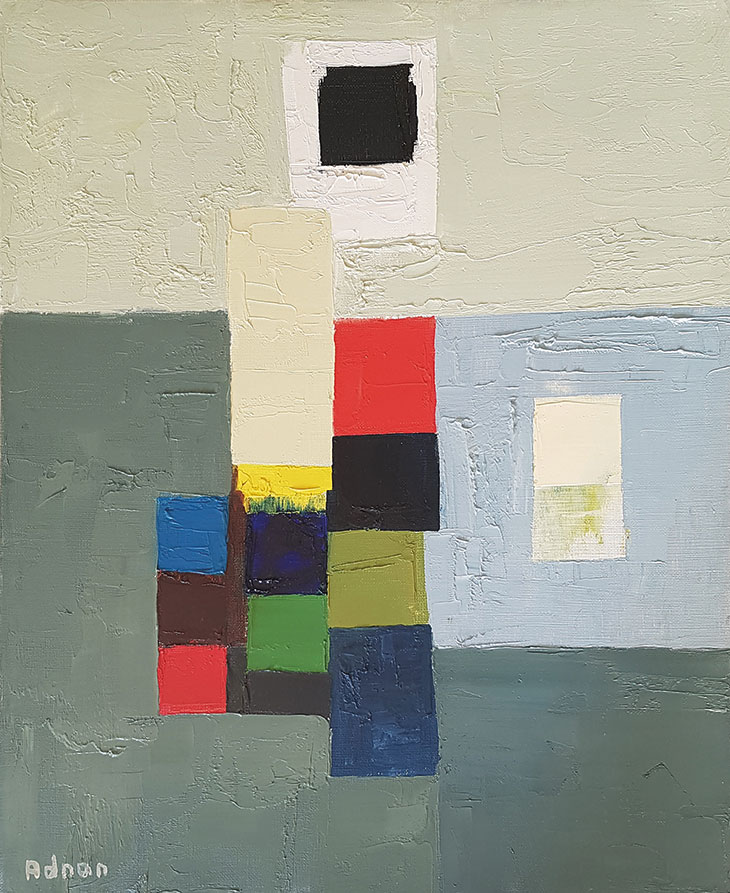
Untitled (1970s), Etel Adnan. Courtesy the artist and Sfeir-Semley Gallery, Hamburg/Beirut; © Etel Adnan
Her next show, opening in June, is at the Zentrum Paul Klee in Bern, Switzerland (15 June–7 October), and mixes together her works with a small selection of pieces by Klee – a few watercolours and oils, as well as one of his macabre hand puppets. She was surprised and touched, she says, by the invitation to exhibit there. Yet she also feels that in some sense, perhaps, it was always destined to happen. ‘Paul Klee is a painter I feel if I have lived with, almost, as if I had gone to the Bauhaus. He was that central, during the ’60s, in California. In the artistic world, he was very famous. Of course the most well known to the Americans were the Abstract Expressionists. But Paul Klee also was very present. People discussed him and quoted him, much more than any of the contemporary American painters.’
The pairing of Adnan’s work with Klee’s makes sense on a formal level, too. There are clear affinities between their methods: the relatively small, often squarish size of their paintings; the radical, geometric simplification of landscape elements; the surfaces which get cleanly divided into tessellated blocks of colour – although the tones Adnan uses are far more luscious, more joyfully radiant, than anything by Klee. It’s fascinating to hear her talk about what she sees as the essential darkness of his work. ‘Klee lived a tragedy, he saw his world collapse,’ she explains. ‘He witnessed the First World War, and how Germany got destroyed; he experienced the rise of Hitler and the Nazis, and the end of the dream of the Bauhaus. And so a profound pessimism runs through his work. For example, he made puppets for his son – but they are not puppets for a child! They are ghostlike, they resemble dead people. Or his angels – there are very few happy angels! They all have these exorbitant eyes, they don’t put you at peace. They are terrified, and terrifying.’
Adnan’s own art conveys a very different mood, a different philosophy of life. And yet, she says, she can understand an attitude like Klee’s – mainly because of her childhood in Beirut, and growing up with parents she describes as ‘two very conflicted people’. She points to a framed black-and-white photograph on the wall of her father, a handsome, mustachioed man in military dress. ‘My father was Syrian, from Damascus, but really he was from the Ottoman Empire. He was an Ottoman officer, a classmate of Atatürk – they went to the same military academy. I was the only child of his second marriage. By the time I was born, he was out of a job. At the age of 38, he was unemployed, because the whole empire had collapsed. And my mother, she was a Greek from Smyrna, and Smyrna also had totally burned to the ground. So I never got to witness their good days; I grew up with people whose worlds, whose lives, had been destroyed. So I understand devastation, I understand refugees, I understand defeat.’
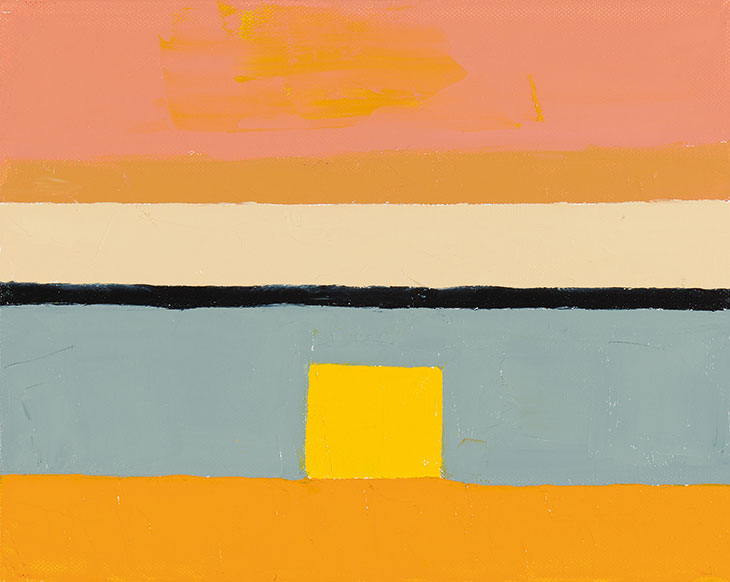
Untitled (2010), Etel Adnan. Courtesy Sfeir-Semley Gallery, Hamburg/Beirut; © Etel Adnan
Perhaps that’s why her own art runs in such an opposing direction – towards expressions of happiness, contentment, confidence. It’s tempting to regard Adnan as a kind of refugee herself, one who fled the limiting confines of her childhood to discover a new way of being, a new way of creating, in the United States – specifically in California. She says she thinks of herself as ‘a Californian artist. I wouldn’t say American. The colours I use, the brightness – they are the colours of California.’ Her works are first and foremost responses to the landscape there: not literal depictions, but abstract embodiments, a way of conjuring up its vastness, its intricacy, its scintillating medley of air and sea and earth. Rich blues, creamy greens, intense reds and ochres – the colours are laid on thickly, often with a palette knife, almost like building up a physical terrain. And while her earlier, more lyrical pieces from the 1960s and ’70s have a fidgety, sun-dappled quality, in her more recent works the contrasting tones jostle and align like geological masses, held precariously, yet solidly, in place.
It was the mountains in California, especially, that she felt drawn to. For many years she lived in the town of Sausalito, near to Mount Tamalpais – an iconic peak whose presence figures again and again in her work, in her writing as well as her painting. ‘That mountain became my best friend,’ she says, ‘it really did. It was more than just a beautiful mountain: it entered me, existentially, and filled my life. It became a poem around which I orientated myself’ – just as, perhaps, in numerous paintings of hers, patches of colour huddle and cluster around a central, sloping, majestically triangular form. It’s one of the occasional concessions her paintings make to notions of figuration – perhaps along with the elemental red disc of what might be the sun hanging above, or a horizontal band of azure to indicate sea.
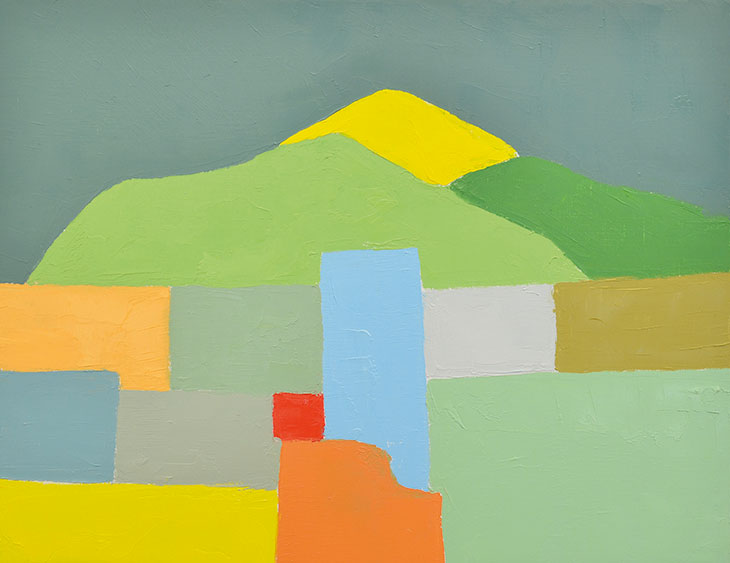
Untitled (2012), Etel Adnan. Private collection. Courtesy Sfeir-Semley Gallery, Hamburg/Beirut; © Etel Adnan
In the past few years, though, her painting has tended more towards pure abstraction. The reason, she thinks, is that she’s not able to travel or take planes any more. She’s evoking an internal landscape, ‘a landscape that is in me’. Still, she says, she misses California terribly, like a physical longing. ‘I could cry. Paris…’ she shrugs. ‘If you’re going to be stuck somewhere, it’s a good place. Professionally, it’s better to be in Europe for the shows. But deep down, I am a Californian. And so I sit, and I work, and sometimes I am there.’
Themes of loss or displacement are fundamental to Adnan’s work; it would be a mistake to say she avoids the dark or disturbing side of life. What’s intriguing, though, is how these aspects are almost entirely confined to her written work, as opposed to her visual art. In the 1970s, having returned to Beirut to work as a journalist, she was forced to flee to Paris when the civil war broke out, and it was there that she wrote her only novel, Sitt Marie Rose (1978) – an angry, brutal work, often cited as the greatest piece of literature to emerge from the war, which imagines the events surrounding the kidnapping and execution of an acquaintance of hers (Adnan had come across the real-life incident in a newspaper). In subsequent years, now living mainly again in California, she published numerous volumes of poetry and prose which, though they range across all sorts of subjects, including her beloved Mount Tamalpais, at their core mainly relate to the ongoing troubles in the Middle East, such as The Arab Apocalypse (1980), Of Cities and Women (Letters to Fawwaz) (1993), and In the Heart of the Heart of Another Country (2005).
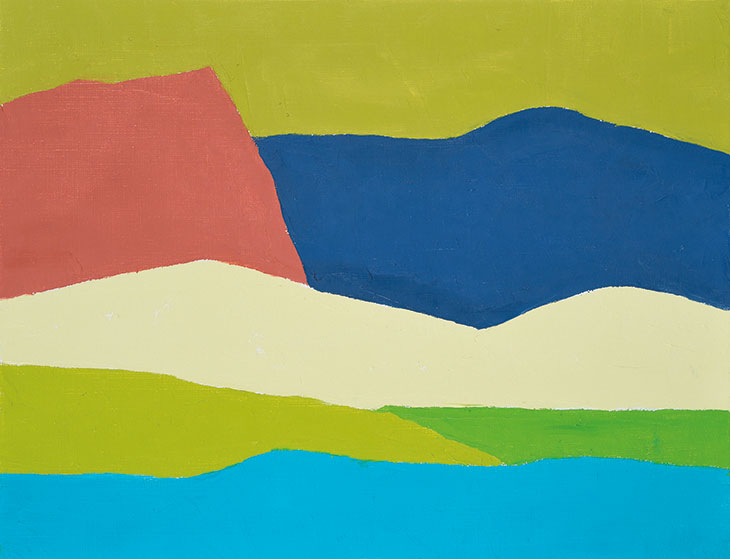
Untitled (2014), Etel Adnan. Private collection. Courtesy Galerie Claude Lemand, Paris; © Etel Adnan
I ask her about this sense of a split, this division in her creative output. ‘I’ve thought about this many times,’ she replies. ‘I didn’t plan it, but looking back you’re right. If I were just a painter, maybe my work would have been different, more encompassing. But my writing is rather pessimistic, because of the angle of history I got involved with, being born in Beirut. Also, it’s because words are social. I think it’s more natural if an event bothers you to express it in words. Art also is a kind of language – but it’s a language of feeling. When I paint, I am happy. I am both an optimistic, happy person, and caught in and aware of tragedy. And although I lived in California most of my life, I never had a spell of time where I could forget about the problems of the Middle East. Every morning the newspaper would remind me.’
The Zentrum Paul Klee exhibition includes other strands of her work, besides painting. There are several works on paper, and three of the large, dazzling woollen tapestries which have been made from her designs in recent years, where the colours seem even more resplendent than ever. But perhaps most interesting, in terms of her parallel practices of art and writing, is the display’s focus on what she refers to as ‘leporellos’ – a term for a sort of pleat-folded, concertina-style book, typically many pages long. It’s a format she began experimenting with while living in California, after coming across leporellos in a Japanese store there – she explains how she had always been fascinated by the connections between Asia and the West Coast, both the cultural influence as well as the similarities in climate and topography. ‘But at first, when I bought this thing, I didn’t know what it was for. I hadn’t seen leporellos used by the Japanese for poetry, or by the Chinese for writing and landscapes. This I discovered later. The guy in the shop told me it was for putting photographs in! But when I saw it, I knew that what I wanted to do was write Arab poetry.’
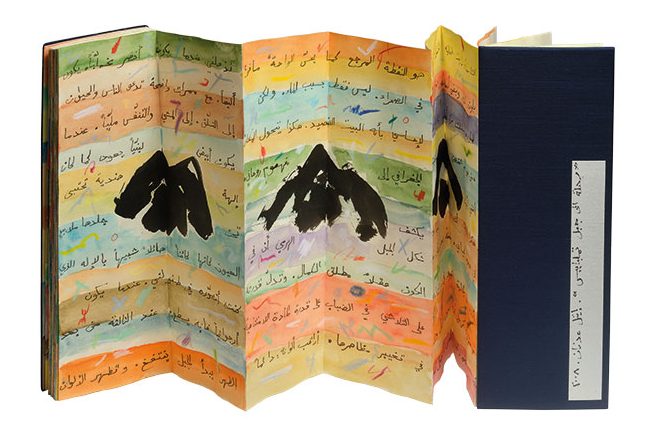
Journey to Mount Tamalpais (2008), Etel Adnan. Private collection Courtesy Galerie Claude Lemand, Paris; © Etel Adnan
She doesn’t mean, though, that she used the leporellos to write her own poetry – not initially, at least. She tells me how she was part of the generation in Lebanon who was taught only in French at school, and punished for speaking Arabic, while at home she spoke Turkish and Greek. So she never became fluent enough in Arabic to compose in it (her own poems tend to be composed in English). It was other contemporary Arabic writers, then, whose poetry she turned to for her leporello pieces – and what attracted her, besides each poems’ meaning, was the process of transcription itself. ‘The flexibility of the Arabic script excited me. In Arabic, you have greater freedom to manipulate writing, visually. You can stretch letters out, you can put one letter on top of another.’ She also added watercolours, coiling delicate, washy patterns around the words or through them – turning the texts into visual art, essentially. ‘In this way I discovered that the act of writing is also an act of drawing.’
It’s a concept that seems to get to the heart of much of what she’s trying to achieve in her art. Later, she would go on to make leporellos using the English words of American poets, or her own writing translated into Arabic, or even completely abstract hieroglyphs of her own devising (again, the parallel with Klee’s work is striking). In each case, just as with her paintings, the basic idea is about slowing down the way we look at things, about intensifying our experience. She likens leporellos to a kind of voyage, like travelling along a river – the way the unfolding pages extend, it makes viewing them more of a continuous process, more akin to the flow of feeling that’s inside us all. And also it goes back to her fascination for Asian cultures. ‘You know, in Japanese and Chinese culture, traditionally, you don’t have images on the wall, but in books. You open a drawer, take out a book – you’re able to look for as long as you want. The gesture of looking at an image, and the way you read a poem, gets closer to an affinity between the arts. You understand that visual art is a matter of meditation, like a poem. I find that rather wonderful.’
‘Etel Adnan’ is at the Zentrum Paul Klee, Bern, until 7 October.
From the June 2018 issue of Apollo. Preview and subscribe here.
Unlimited access from just $16 every 3 months
Subscribe to get unlimited and exclusive access to the top art stories, interviews and exhibition reviews.

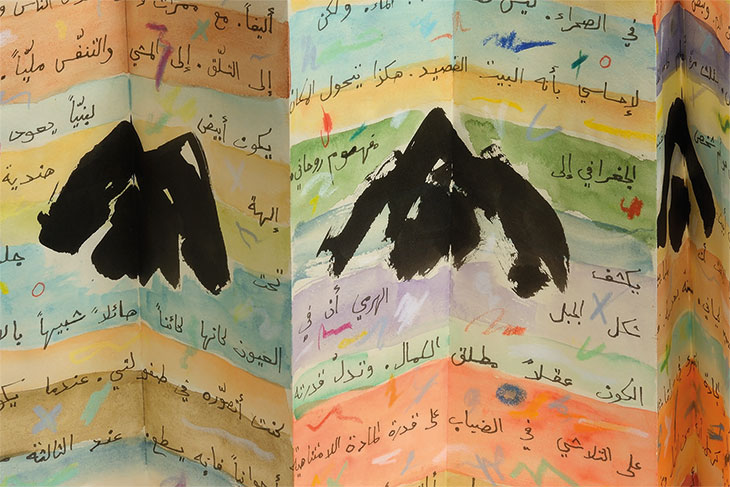

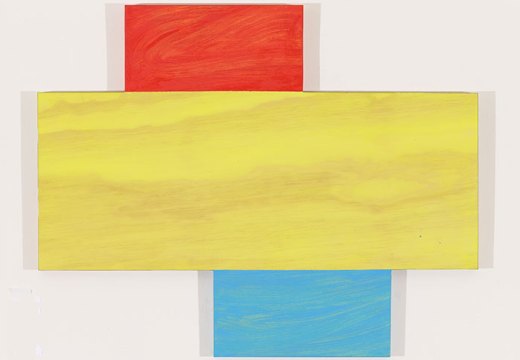
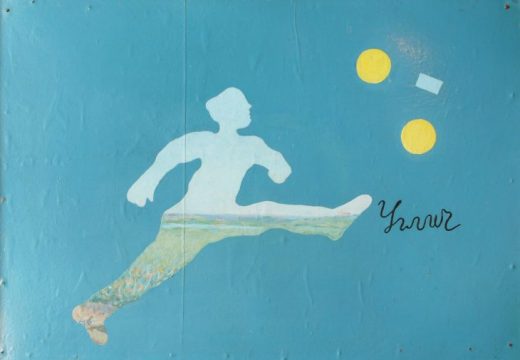









![Masterpiece [Re]discovery 2022. Photo: Ben Fisher Photography, courtesy of Masterpiece London](http://www.apollo-magazine.com/wp-content/uploads/2022/07/MPL2022_4263.jpg)
It’s time for the government of London to return to its rightful home